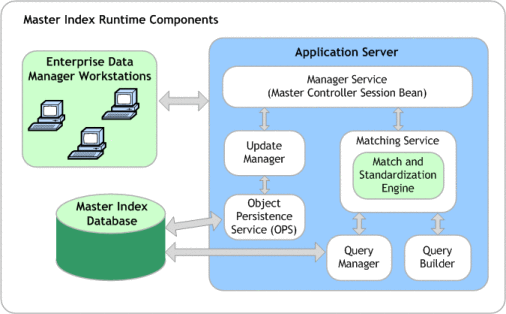Master Index Runtime Components
The master index applications created by Sun Master Index are made up of several components that work together to form the complete indexing system. The primary components of the master index application include the following:
In addition, the master index application uses the connectivity components defined in the Sun Master Index server and client projects to route data between external systems and the master index application.
The Java CAPS repository stores information about the configuration and structure of the master index environment. Because the master index application is deployed within the repository, it can be implemented in a distributed environment. The master index system requires the Sun Java System Application Server.
The components of a master index application are illustrated in the following figure.
Figure 2 Master Index Runtime Components

Matching Service
The Matching Service stores the logic for standardization (which includes data parsing and normalization), phonetic encoding, and matching. It includes the specified standardization and match engines, along with the configuration you defined for each. The Matching Service also contains the data standardization tables and configuration files for the match engine. The configuration of the Matching Service is defined in the Match Field file.
Manager Service
The Manager Service provides a session bean to all components of the master index application, such as the Enterprise Data Manager, Query Builder, and Update Manager. The service also manages connectivity to the master index database. The configuration of the Manager Service specifies the query to use for matching and defines system parameters that control EUID generation, matching thresholds, and update modes. The configuration of the Manager Service is defined in the Threshold file.
Query Builder
The Query Builder defines all queries available to the master index application, including the queries performed automatically by the master index application when searching for possible matches to an incoming record. It also includes the queries performed manually through the Enterprise Data Manager (EDM). The EDM queries can be either alphanumeric or phonetic and have the option of using wildcard characters. The configuration of the Query Builder is defined in the Candidate Select file.
Query Manager
The Query Manager is a service that performs queries against the master index database and returns a list of objects that match or closely match the query criteria. The Query Manager uses classes specified in the Match Field file to determine how to perform a query for match processing. All queries performed in the master index application are executed through the Query Manager.
Update Manager
The Update Manager controls how updates are made to an entity’s SBR by defining a survivor strategy for each field. The survivor calculator in the Update Manager uses these strategies to determine the relative reliability of the data from external systems and to determine which value for each field to populate into the SBR. The Update Manager also manages certain update policies, allowing you to define additional processing to be performed against incoming data. The configuration of the Update Manager is defined in the Best Record file.
Object Persistence Service (OPS)
OPS is a database service that translates high-level and descriptive object requests into actual JDBC calls. The service provides mapping from the Java object to the database and from the database to the Java object.
Database
The master index application uses an Oracle or SQL Server database to store the information you specify for the business objects being cross-referenced. The database stores local system records, the single best record for each object record, and certain administrative information, such as drop-down menu lists, processing codes, and information about the systems from which data originates. The scripts that are generated to create the database tables are based on the information specified in the Object Definition file.
Enterprise Data Manager
The Enterprise Data Manager (EDM) is a web-based interface that allows you to monitor and maintain the data in your master index database. Most of the configurable attributes of the EDM are defined by information you specify in the wizard, but you can further configure the EDM in the Enterprise Data Manager file after you generate the Sun Master Index application. The EDM provides the ability to manually search for records; update, add, deactivate, and reactivate records; merge and unmerge records; view potential duplicates; and view comparisons of object records.
- © 2010, Oracle Corporation and/or its affiliates
